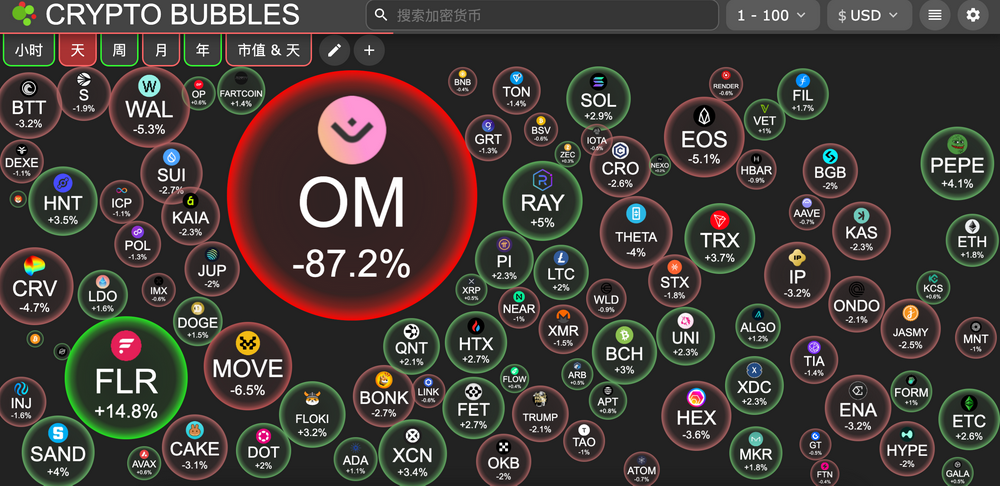Trading time: OM flash crash caused nearly 5.5 billion market value to evaporate, and BTC whale behavior was highly similar to the accumulation period in August-September last year

1. Market observation
Keywords: OM, ETH, BTC
The RWA project MANTRA (OM) plummeted this morning, with the price falling from $6.35 to $0.38 in a short period of time, causing the market value to evaporate by more than $5.5 billion. Faced with market panic, the MANTRA team quickly issued a statement attributing the decline to "irrational liquidation" and emphasizing that it had nothing to do with the fundamentals of the project. However, in-depth observation found that OM has experienced many violent pull-ups since November last year, and has long been labeled as a "strong monster coin" in the community. Community analysis revealed that MANTRA has many structural problems, including high control, repeated changes in airdrop rules, and the team actually controlling 90% of the supply. These factors have led to its extremely low actual circulation, making the price extremely easy to manipulate, and ultimately triggered the crash. In addition, the market value of $RFC on the Solana chain exceeded $100 million, becoming the only Meme coin to break 100 million in the near future. At the same time, the market has also seen the emergence of a spoof derivative currency similar to fartcoin, $DB, and the Meme coin $MUTUMBO that attracted attention due to Ansen's shouting.
Despite the increased volatility in the global market, BTC whale investors have not withdrawn from the market. According to data analysis by CryptoQuant, the current behavior pattern of BTC whales is highly similar to the accumulation phase during the sideways trading period from August to September last year, indicating that large funds are still strategically positioned. Although the S&P Volatility Index has soared to its highest level since August last year, clearly showing that market uncertainty is rising, the ratio of Bitcoin to VIX has hit the long-term trend line support. Historical data shows that whenever the Bitcoin/VIX ratio hits this trend line, it often marks the stage bottom of Bitcoin prices, followed by a significant rebound, which provides technical support for the current market. Arthur Hayes, co-founder of BitMEX, boldly predicted that if the current market situation continues, Bitcoin may enter a "only up and no down mode". Ryan Lee, chief analyst at Bitget Research, predicted that the price of BTC may fluctuate between $80,000 and $85,000, and advised traders to pay close attention to the macroeconomic situation and capital flows. It is worth noting that Andrew Kang, co-founder of Mechanism Capital, recently went long on BTC at a price of $77,000 with 40x leverage and doubled his Bitcoin holdings to $200 million, and has now achieved a profit of $6.8 million.
In the field of regulation, Tim Scott, chairman of the U.S. Senate Banking, Housing and Urban Affairs Committee, recently released a positive signal, predicting that the Cryptocurrency Market Structure Act will officially become law by August 2025. He also pointed out that the Senate Banking Committee has advanced a comprehensive stablecoin regulatory bill, the GENIUS Act, in March 2025, indicating that the U.S. legislature is making crypto policy a priority. In addition, the tariff exemption policy announced by Trump over the weekend, especially the exemption measures for semiconductors and computer components, was interpreted by the market as a long-term positive for the crypto ecosystem. These core components are essential for cryptocurrency mining, blockchain infrastructure construction, and the development of AI-based crypto tools. This policy indirectly boosted confidence in the crypto market and pushed the price of Bitcoin back to $85,900.
However, the global macroeconomic situation is facing major challenges, and several Wall Street giants have issued warnings. BlackRock CEO Larry Fink warned that the United States may have begun to enter a recession, citing intensified economic pressures and protectionist trade policies as the main drivers. Meanwhile, JPMorgan Chase CEO Jamie Dimon said he was preparing for possible chaos in the nearly $30 trillion U.S. Treasury market and expected the Fed to act only if the market began to panic. According to data from the U.S. Treasury Department in January this year, Japan held $1.079 trillion in U.S. Treasury bonds, ranking first, followed by China, which held $760.8 billion. Against the backdrop of increasing global economic uncertainty, the gold market performed well, with spot gold prices breaking through historical highs to $3,245.45 per ounce. Major investment banks have raised their gold price forecasts: Goldman Sachs expects gold prices to reach $3,700 by the end of the year, and may even reach $4,500 in extreme cases; UBS also raised its forecast to $3,500, believing that Chinese investors have strong buying potential. As the global order is restructured, the continued growth in demand for gold by central banks will provide long-term support for gold prices.
2. Key data (as of 12:00 HKT on April 14)
(Data sources: Coinglass, Upbit, Coingecko, SoSoValue, GMGN, Tomars)
-
Bitcoin: $84,781.34 (-9.58% year-to-date), daily spot volume $30.943 billion
-
Ethereum: $1,637.32 (-50.96% year-to-date), with a daily spot volume of $14.762 billion
-
Fear and corruption index: 31 (panic)
-
Average GAS: BTC 1.06 sat/vB, ETH 0.43 Gwei
-
Market share: BTC 62.6%, ETH 7.3%
-
Upbit 24-hour trading volume ranking: XRP, AERGO, BTC, COW, ORCA
-
24-hour BTC long-short ratio: 1.0969
-
Sector gains and losses: RWA sector fell 44.62%, SocialFi sector fell 1.89%
-
24-hour liquidation data: A total of 137,857 people were liquidated worldwide, with a total liquidation amount of US$334 million, including BTC liquidation of US$87.13 million, ETH liquidation of US$56.75 million, and OM liquidation of US$71.55 million
-
BTC medium- and long-term trend channel: upper channel line ($83,334.67), lower channel line ($81,684.48)
-
ETH medium and long-term trend channel: upper channel line ($1682.34), lower channel line ($1649.02)
*Note: When the price is higher than the upper and lower edges, it is a medium- to long-term bullish trend; otherwise, it is a bearish trend. When the price passes through the cost range repeatedly within the range or in the short term, it is a bottoming or topping state.

3. ETF flows (as of April 11 EST)
-
Bitcoin ETF: -$1.03 million
-
Ethereum ETF: -$29.2 million
4. Today’s Outlook
-
KernelDAO announces TGE of KERNEL token
-
Binance launches KERNEL and opens five trading pairs including KERNEL/USDT, and the seed tag rules apply
-
Layer1 blockchain Shardeum launched mainnet on April 15
-
Russia's VK shuts down its NFT platform on April 15 , and users are required to migrate their assets as soon as possible before this day
-
WalletConnect to Launch WCT Token on April 15
-
Sei (SEI) will unlock 225 million tokens on April 15, worth approximately $38.5 million
-
Solayer (LAYER) will unlock 48.15 million tokens on April 15, worth approximately $67.7 million
-
Starknet (STRK) will unlock 163 million tokens on April 15, worth approximately $24.4 million
The biggest increases in the top 500 stocks by market value today: RFC up 87.42%, GODS up 82.64%, DOGINME up 33.16%, AERGO up 26.29%, and ALCH up 20.23%.

5. Hot News
-
This week's preview | Trump tokens worth $342 million will be unlocked on April 18; Layer1 blockchain Shardeum goes live on the mainnet
-
Data: FTN, CONX, QAI and other tokens will be unlocked in large amounts next week, of which FTN unlocks about $81 million
-
Macro Outlook of the Week: Trump "plays too hard", Fed officials will go all out
-
Bloomberg: The Trump family’s cryptocurrency projects have a total book profit of nearly $1 billion
-
Analyst: Bitcoin to VIX ratio has hit the long-term trend line, which may indicate that Bitcoin has bottomed out
-
BlackRock CEO: Economic recession may have begun, but the release of new liquidity may become a catalyst for cryptocurrencies
-
Santiment: Tariff exemption policy triggers positive response in crypto market, Bitcoin breaks through $83,000 resistance
-
NFT transaction volume fell 4.7% to $94.7 million in the past 7 days, and the number of buyers and sellers fell by more than 70%
-
The United States: Some products imported from China are exempted from "reciprocal tariffs", including smartphones, some computers and notebooks, etc.
-
Analysis: BTC’s relationship with gold is “breaking”, and the recent weakness may be due to the market digesting the positive news after reaching the peak of $109,000
-
Analyst: BTC may fluctuate between $80,000 and $85,000, and we should pay close attention to the macroeconomic situation and capital flows
-
Trump Tokens worth $321 million will be unlocked
-
Bitcoin spot ETFs had a net outflow of $713 million last week, with BlackRock IBIT leading the way with a weekly net outflow of $342 million
-
Japanese listed company Metaplanet announced that it has increased its holdings of 319 Bitcoins
-
A whale/institution withdrew 15,953 ETH from OKX 5 hours ago, worth $26.16 million
-
Janover, a US listed company, increased its holdings of 44,158 SOLs, bringing its total holdings of SOLs to 83,084
-
Ethereum Foundation members share simplified roadmap, including expanding blobs, expanding L1, and improving UX
-
Before the OM crash, at least 17 wallets deposited 43.6 million OM on exchanges, accounting for 4.5% of the circulating supply.
-
A whale sold 1.56 million Fartcoins and bought 11.62 million RFCs, causing the market value of RFC to exceed $100 million in a short period of time.
Vous aimerez peut-être aussi

Gary Gensler Insists His Crypto Enforcement Actions Were Justified

DBS lists Franklin Templeton’s sgBENJI token and Ripple’s RLUSD stablecoin on its exchange

